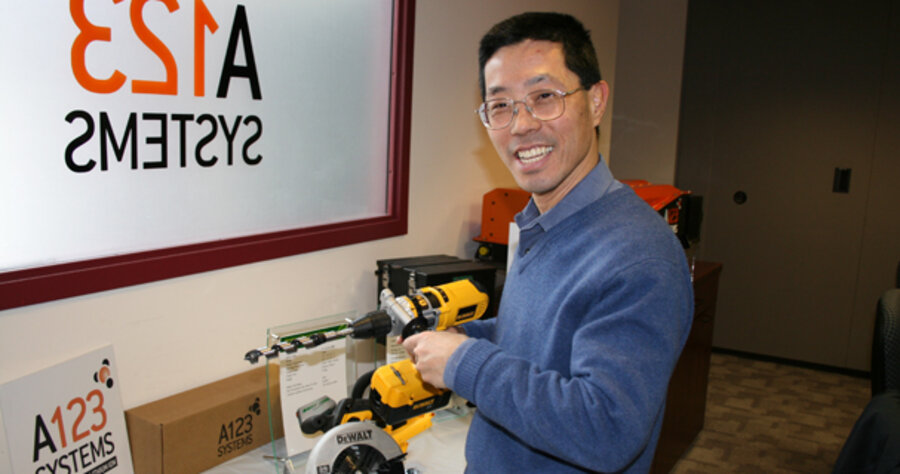Battery tech starts catching up to high tech
| WATERTOWN, MASS.
Standing at the base of a gym's climbing rope, Nathan Ball checks his harness and prepares to live every gym student's dream. He flicks a switch on his "rope ascender" and zips up to the 45-foot ceiling in less than five seconds. The 15-pound battery-powered device, designed by Mr. Ball and three fellow Massachusetts Institute of Technology students, can hoist 250 pounds at 10 feet per second (about 7 miles per hour).
"You need an insane amount of power to do that at that speed, with that weight load," explains Ball.
Enter the nanotechnological battery, the new lightweight and powerful engine of high-tech dreams, making everything possible from Ball's rope ascender to hybrid vehicles capable of getting 150 miles per gallon to battery-powered fabrics that will let soldiers plug electronic devices into their uniforms.
Recent advances in nanotechnology – the science that alters elements at the atomic level – have allowed the battery industry to begin to catch up to the electronics industry. For a long time, the battery industry was "sort of the afterthought of the electronics industry," says Steve Simon, executive vice president of research and development at mPhase Technologies, a company trying to build a better battery.
Every year the portable electronics industry packs more into smaller spaces – iPods, cellphones, and laptops. Microprocessors, the core component of personal computers, have doubled in speed nearly every 18 months since the late 1960s, Mr. Simon says. By comparison, he adds, batteries have seen 3 to 4 percent increases in performance over the past 20 years.
Responding to this, Reno, Nev.-based Altair Nanotechnologies developed nanomaterials that resulted in safer, more powerful batteries. By early 2005, battery manufacturers had shown little interest, so Altair assembled its own battery development team.
Lithium-ion batteries, commonly used in laptops and cellphones, have a relatively short life span because they use graphite, which wears out quickly in normal usage. The Altair team substituted a nanomaterial called lithium titanate that lasts much longer.
Better, safer battery for laptops – and motorcycles
The change lengthened the life of a lithium-ion battery from 750 recharges to between 10,000 and 15,000 recharges. It also made the battery safer. Graphite can cause shorts that create fires, like those that caused Dell and Apple to recall laptop batteries last summer.
A123 Systems, maker of the battery in Ball's rope ascender, used a different nanomaterial to improve the lithium-ion battery. Researchers developed nanophosphate, phosphate in particles a few billionths of a meter in size. Most safety issues in batteries occur during charging, and nanophosphate is much less prone to such problems. So A123 replaced the cobalt oxide in lithium-ion cells with nanophosphate.
"The fact that it's safe is not enough to make a compelling new application," says Yet-Ming Chiang, founder of A123 and a materials-chemistry professor at MIT. "The other critical performance attribute is that nanophosphate can deliver extraordinarily high power while being safe."
Bill Dubé, a member of the KillaCycle electric motorcycle drag-racing team, used A123 batteries to create an electric motorcycle that goes from zero to 60 in 1.4 seconds.
On a more practical level, DeWalt used A123 batteries in a new line of cordless power tools. They are twice as strong as their corded counterparts and five times as strong as the battery-powered ones they replaced. The battery lasts for 2,000 recharges.
The number of recharges is of particular interest to the auto industry. Unlike personal electronics, which are expected to last only a few years before consumers upgrade to the next- generation gadget, cars must last at least a decade. With high numbers of recharges a prominent feature of both A123 and Altair's batteries, both companies have begun working to develop better hybrid and electric options.
Conversion kit makes a hybrid car even better
A123 created a conversion kit (yet to hit the market) that turns normal hybrids into plug-in hybrids capable of getting 150 m.p.g. in city driving. Plug-ins require an overnight charge from a normal wall socket to get the extra mileage. According to 2007 Environmental Protection Agency estimates, the Toyota Prius gets 60 m.p.g. General Motors also contracted A123 to help produce the Saturn Green Line Vue, a plug-in hybrid.
Addressing another challenge facing the battery industry, mPhase created a battery with an indefinite shelf life. Traditional batteries, like AAs, gradually lose power even when they're not being used. Some can lose up to half of their charge over five years in storage.
Using nanomaterials and basic physics principles, mPhase kept the chemicals inside the battery from mixing – the cause of gradual power leakage – until it was used. Such batteries could be used for emergency lighting systems, for example, that might not be used for 10 years, but would require full power when needed.
While current battery innovations offer exciting opportunities, science fiction-like possibilities beckon.
Prof. Angela Belcher, a biomolecular materials chemist at MIT, is trying to use biological methods, such as viruses, to assemble batteries. "The goal is to have biology make things in an environmentally friendly way," says Professor Belcher.
Belcher's virus-assembled batteries are thin, transparent sheets that look like plastic wrap. They could be used to create smart credit cards or lightweight hearing-aid batteries. Eventually, Belcher hopes to weave battery cells into textile fibers to create battery-powered fabrics. Soldiers might plug night-vision goggles into their uniforms, for example, instead of traditional batteries.
Professor Chiang, who also researches self- assembling batteries, imagines an ink-like substance that would allow one to "paint" a battery onto a device.
As far-fetched as it seems, Chiang is optimistic that such advances are within reach. "We're not talking about something that's going to take 20 or 30 years, within the next decade it could very well happen," he says.





